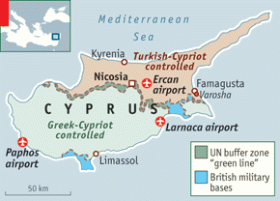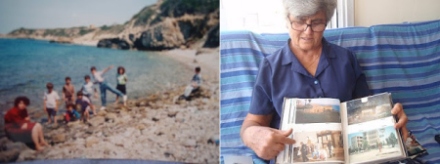Kyrenia harbor and castle. Source: Cyprus 44
Below is the second and final part of the story Marlene Philippou has shared with us. Once again, thank you so much for you soulful story, Marlene! Again, scroll down to the end to see Marlene’s personal photos of her visit back to Kyrenia after 29 years.
‘And so, after the Turkish invasion- a major landmark in my life – another life began. We had to flee and seek protection in other parts of Cyprus, we became refugees in our own country. The trauma and memories of this intense experience brought, without doubt, early maturity on us. We grew up too fast. As a teenager, I really should have been worried about where to hang out with my friends, going to parties, playing with my cats, having fun at our school excursions with my classmates, decorating my room with posters of my favourite pop stars (David Cassidy, Jonny Osmond), counting the stars on clear nights with my neighbourhood friends, swimming at our beach…and more…
Instead, I lost my house, my personal things, my friends, my neighbourhood, my school, my hometown. And I lost my uncle, who was declared missing and still remains so after 39 years! His parents eventually passed away carrying that deep sorrow in their heart. So many “why’s”. So much pain in my heart.
29 years after I returned. The crossroads opened up all of a sudden… I was in awe of what was happening. My home was such a short distance away from Nicosia, yet it has been so far away and out of reach, for so long. The night before I hardly slept. I dreamt of what my house would look like. I dreamt of what my neighbourhood would look like. I dreamt that maybe I would find old photographs, any furniture, anything from our house…
I waited 6 hours at the barracks. I was holding my breath as I was walking hurriedly towards our house. 29 years after I returned, not as a teenager. I was a grown woman, I was a mother now. I had two daughters and I wanted very badly to show them where my “first” life was. Alas, I was devastated. No house was there…no big citrus fruit orchard was there. Just the old external stone wall that went round our house and out of which my brother couldn’t see when we had left. He was now taller! And 4 big blocks of flats had been built in our house’ place. I was torn apart. I felt a huge gap between my two lives. I couldn’t find a way of mending that gap. I couldn’t put the pieces together. I wanted to walk inside my house, re-live my life there, touch, smell the citrus fruit, our jasmine plant… I could not. This was not possible for me.
Today, 39 years after the situation remains. My pain is still there. My nostalgia is getting stronger. My love for my homeland, becomes stronger by the day. My desire to be able to live in Kyrenia,also stronger.
My name is Marlene Michaelidou Philippou. I come from the island of Cyprus. I was born and raised in Kyrenia. I am Greek-Cypriot. I am a refugee in my own country. I was forced out of my home and town in 1974. I have been deprived for the past 39 years of my right to live in the place where I was born. I have been deprived of the right to show my children where I was born and grew up. I am deprived of living in the land of my ancestors and the land I love. I can travel and live anywhere else in the world. Yet not where my roots are and not where my soul resides.’


















